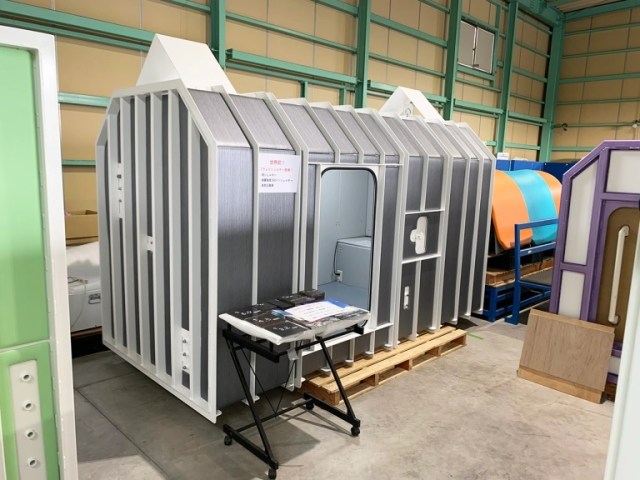
Seiji learns about the importance of “positive pressure.”
On his recent trip to Hokkaido, our Japanese-language reporter Seiji Nakazawa experienced some of the most wide-open scenery the prefecture has to offer. Today, though, he’s going the opposite route, with a visit to Japan’s number-one maker of disaster and emergency shelters.
World Net’s headquarters is in Tokyo, but Seiji paid a visit to the company’s showroom in Yaizu, Shizuoka Prefecture.
His guide for the day was none other than the company’s president, Hiroki Nakajima. World Net is the only company in Japan that handles both emergency shelter design and assembly, and the impetus for their shelters came when Nakajima visited Ishinomaki, one of the worst-hit towns in the 2011 Tohoku tsunami. “After that, I wanted to make something that could protect people” Nakajima says, and the first shelters World Net built were tsunami shelters.
▼ Hiroki Nakajima
World Net has since expanded its line to include earthquake shelters, flood shelters, and nuclear shelters, and it’s an example of that last category that Nakajima would be showing Seiji on this day.
“For a nuclear shelter, it’s critical that it be able to achieve positive pressure quickly,” Nakajima explained, referring to a condition in which the air pressure inside the shelter is higher than the environmental air pressure outside it. “You can’t achieve positive pressure unless the shelter is completely sealed, so when you do have positive pressure, the interior is protected against radioactive material outside.”
“From the time between when a missile is launched somewhere and the Japanese government can sound an alarm for the civilian population, it takes about five minutes, and then there’d be about another five minutes before the missile hits Japan. So unless you can achieve positive pressure in that amount of time, allowing for the time it takes to get into the shelter too, there’s no point, so that’s why the speed of creating positive pressure is so important.”
It all made sense to Seiji’s layman ears, but he also couldn’t help wondering what being in a space with positive pressure does to your body. Would it put your lungs in a vice grip, rendering you incapable of drawing breath? Would it make your eyes explode?
Both curious and terrified, he decided to find out.
Stepping into the shelter, there was about as much floor space as a king-sized mattress would take up. At 165 centimeters (65 inches) tall, Seiji had enough room to stand up straight, and Nakajima informed him that World Net can make shelters of different dimensions by customer request.
Looking to his left, Seiji saw an air conditioning unit and a TV. The TV is probably so that you can watch news reports and government announcements, but it’d also probably come in handy if Seiji wanted to pass the time while watching some anime until it was safe to come back out of the shelter. The shelter has its own power supply, but you can also hook it up to the electrical grid and even attach a Lan cable for Internet access.
On the opposite wall was some sort of machinery with a serious cyberpunk aesthetic to it. This, Nakajima explained, is the positive pressure-producing apparatus.
“Let’s turn it on,” Nakajima said, closing the door and activating the device. Seiji, still anxious about what sort of effects the extra air pressure would have on his body, began thinking of all the things he still wanted to do in life, as long as he survi-
Without warning, a fan mounted in the ceiling began to spin.
“OK, that’s it, we’ve got positive pressure,” Nakajima nonchalantly explained.
Wait, what? Seiji didn’t feel any different. He could still breathe, and neither one of his eyelids had ruptured.
“Feels pretty normal, doesn’t it?” Nakajima said, apparently knowing what Seiji was thinking. “It’s just three percent higher than the outside air pressure, so the most you might feel is a little bit of extra pressure in your ears, but even then it’s less noticeable than driving into a highway tunnel.”
▼ It was comfortable enough that if he’d had his laptop with him, Seiji could have typed up his report right there inside the shelter.
So how much does a shelter like this cost? The one Seiji tried out, which is listed as a two-person shelter, is 8.8 million yen (US$63,300), but a one-person shelter of the same type would be 6.8 million yen. Another factor is the thickness of the walls. The shelter Nakajima had shown him has 3.2-milimeter (0.13-inch) thick walls, the thinnest World Net offers but still strong enough to withstand the air pressure impact of a missile hitting 10 kilometers (6.2 miles) away. On the other end of the spectrum, the maximum-thickness 36-millimeter walls are calculated to be effective against an impact five kilometers away, and Nakajima is confident that even a tank smashing into the walls won’t break them.
A 36-millimeter-wall two-person shelter will run you about 12.8 million yen. Seiji couldn’t help thinking that with that much money, he could buy a Porsche, but if a missile is ever headed his way, he figures he’ll probably want to be inside something sturdier than a sports car at the time.
Related: World Net
Photos ©SoraNews24
● Want to hear about SoraNews24’s latest articles as soon as they’re published? Follow us on Facebook and Twitter!
[ Read in Japanese ]


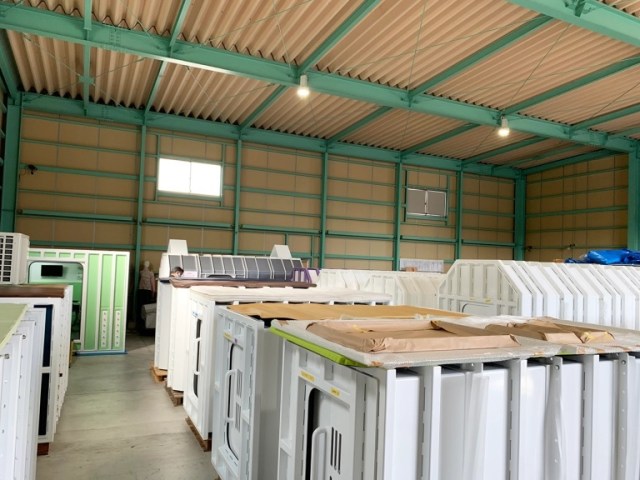
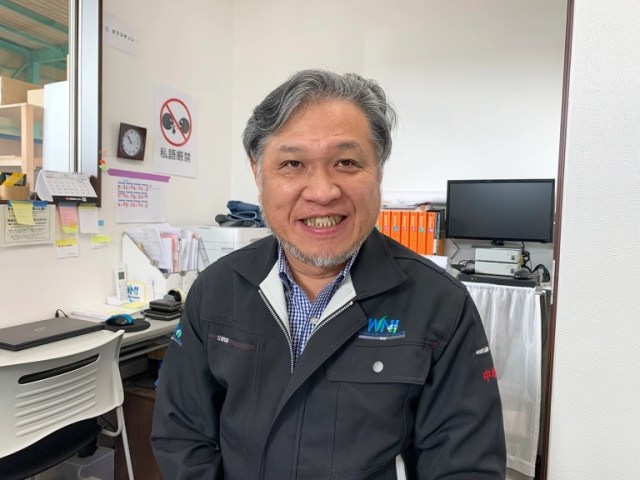
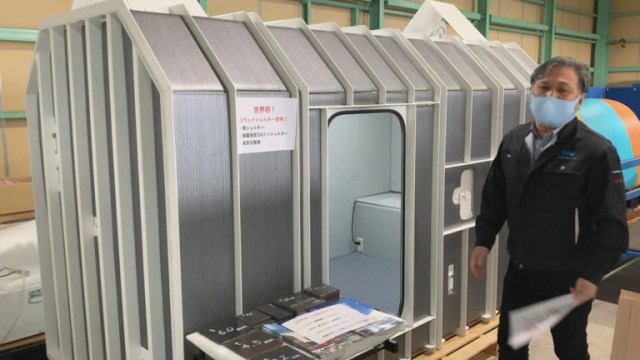
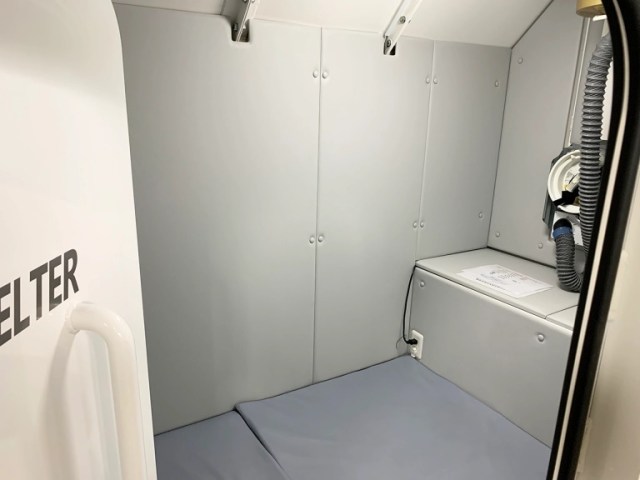
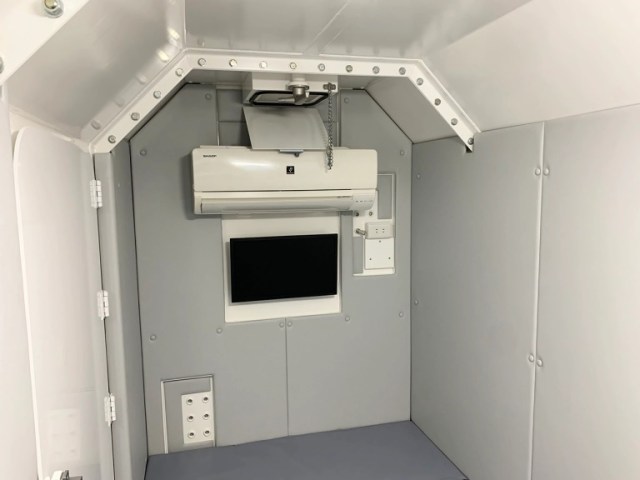
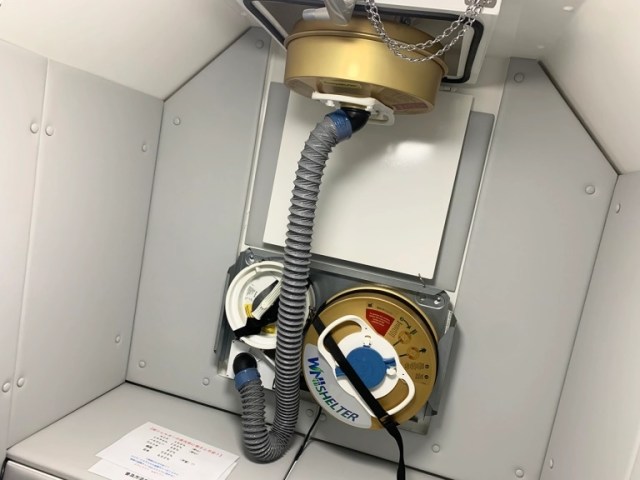
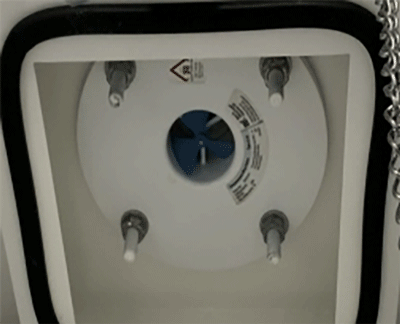
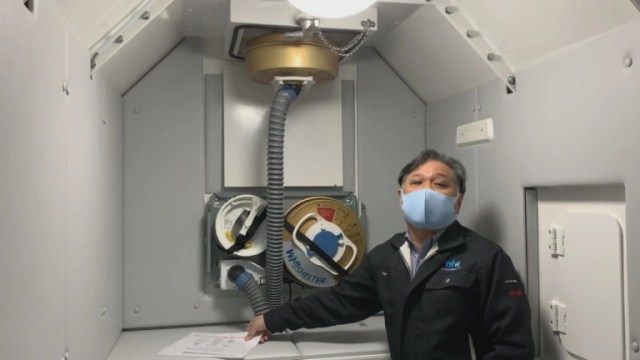
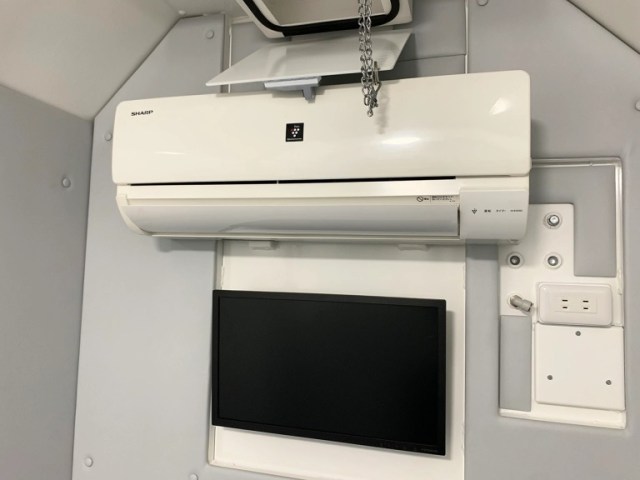
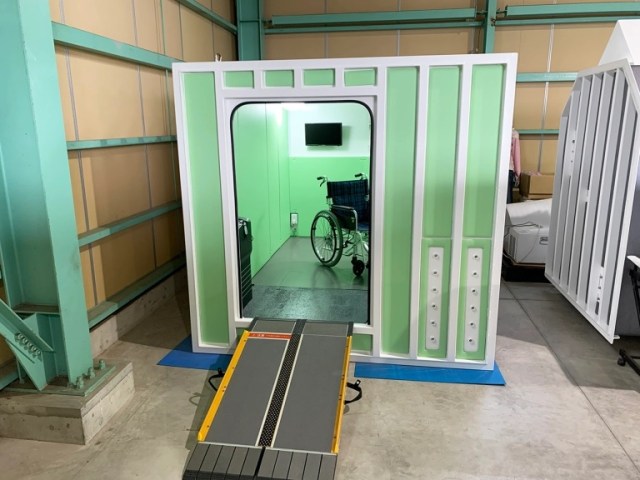
 Turtle spotted riding Tokyo subway makes commuting in Japan’s busiest city adorable【Video】
Turtle spotted riding Tokyo subway makes commuting in Japan’s busiest city adorable【Video】 Godzilla speaks! Interview with 12-movie veteran kaiju actor Haruo Nakajima【Video】
Godzilla speaks! Interview with 12-movie veteran kaiju actor Haruo Nakajima【Video】 Studio Ghibli displays The Boy and the Heron Academy Award Oscar in Japan for a limited time
Studio Ghibli displays The Boy and the Heron Academy Award Oscar in Japan for a limited time Why did this stand-and-eat soba noodle shop in Tokyo open in the middle of the pandemic?
Why did this stand-and-eat soba noodle shop in Tokyo open in the middle of the pandemic? How to put together an earthquake/typhoon preparedness kit at the 100 yen shop
How to put together an earthquake/typhoon preparedness kit at the 100 yen shop Japan’s new difficult-to-drink-from beer glass protects your liver, but it’s a brutal experience
Japan’s new difficult-to-drink-from beer glass protects your liver, but it’s a brutal experience How to order snacks on a Shinkansen bullet train in Japan
How to order snacks on a Shinkansen bullet train in Japan New Pokémon ice cream, dessert drinks, and cool merch coming to Baskin-Robbins Japan【Pics】
New Pokémon ice cream, dessert drinks, and cool merch coming to Baskin-Robbins Japan【Pics】 Demon Slayer: Kimetsu no Yaiba gets new roller coaster attractions and food at Universal Studios Japan
Demon Slayer: Kimetsu no Yaiba gets new roller coaster attractions and food at Universal Studios Japan New samurai glasses are Japan’s latest weird must-have souvenir
New samurai glasses are Japan’s latest weird must-have souvenir Doraemon found buried at sea as scene from 1993 anime becomes real life【Photos】
Doraemon found buried at sea as scene from 1993 anime becomes real life【Photos】 Hello, cosmetics! Clinique teams up with Hello Kitty this summer for first-time collaboration
Hello, cosmetics! Clinique teams up with Hello Kitty this summer for first-time collaboration To combat declining birth rate, Japan to begin offering “Breeding Visas” to foreigners
To combat declining birth rate, Japan to begin offering “Breeding Visas” to foreigners Nintendo history you can feel – Super NES, N64, and GameCube controllers become capsule toys
Nintendo history you can feel – Super NES, N64, and GameCube controllers become capsule toys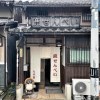 This Nara workshop has been making deer crackers for more than 100 years and offers tours【Photos】
This Nara workshop has been making deer crackers for more than 100 years and offers tours【Photos】 “The most Delicious Cup Noodle in history” – Japan’s French Cup Noodle wins our heart【Taste test】
“The most Delicious Cup Noodle in history” – Japan’s French Cup Noodle wins our heart【Taste test】 Starbucks releases a cute Frappuccino and Unicorn Cake…but not in Japan
Starbucks releases a cute Frappuccino and Unicorn Cake…but not in Japan Kyoto Tower mascot termination reveals dark side behind cute Japanese characters
Kyoto Tower mascot termination reveals dark side behind cute Japanese characters McDonald’s Japan’s Soft Twist Tower: A phantom ice cream only sold at select branches
McDonald’s Japan’s Soft Twist Tower: A phantom ice cream only sold at select branches Yabai Ramen: What makes this Japanese ramen so dangerous?
Yabai Ramen: What makes this Japanese ramen so dangerous? Finally! Nintendo Japan expands Switch 8-bit controller sales to everybody, Online member or not
Finally! Nintendo Japan expands Switch 8-bit controller sales to everybody, Online member or not Japanese government wants to build luxury resorts in all national parks for foreign tourists
Japanese government wants to build luxury resorts in all national parks for foreign tourists 10 things you should buy at 7-Eleven in Japan
10 things you should buy at 7-Eleven in Japan Studio Ghibli releases anime heroine cosplay dresses that are super comfy to wear
Studio Ghibli releases anime heroine cosplay dresses that are super comfy to wear Woman charged for driving suitcase without a license in Osaka
Woman charged for driving suitcase without a license in Osaka Studio Ghibli unveils My Neighbour Totoro miniature house model
Studio Ghibli unveils My Neighbour Totoro miniature house model Kyoto experiencing problems with foreign tourists not paying for bus fares, but not on purpose
Kyoto experiencing problems with foreign tourists not paying for bus fares, but not on purpose Fighting mild hunger with a Japanese soda that turns into jelly in the stomach【Taste test】
Fighting mild hunger with a Japanese soda that turns into jelly in the stomach【Taste test】 Studio Ghibli’s Howl’s Moving Castle tapestry unveiled in Japan for first time
Studio Ghibli’s Howl’s Moving Castle tapestry unveiled in Japan for first time McDonald’s new Happy Meals offer up cute and practical Sanrio lifestyle goods
McDonald’s new Happy Meals offer up cute and practical Sanrio lifestyle goods Sales of Japan’s most convenient train ticket/shopping payment cards suspended indefinitely
Sales of Japan’s most convenient train ticket/shopping payment cards suspended indefinitely Sold-out Studio Ghibli desktop humidifiers are back so Totoro can help you through the dry season
Sold-out Studio Ghibli desktop humidifiers are back so Totoro can help you through the dry season Japanese government to make first change to romanization spelling rules since the 1950s
Japanese government to make first change to romanization spelling rules since the 1950s Foreigner’s request for help in Tokyo makes us sad for the state of society
Foreigner’s request for help in Tokyo makes us sad for the state of society Ghibli founders Toshio Suzuki and Hayao Miyazaki contribute to Japanese whisky Totoro label design
Ghibli founders Toshio Suzuki and Hayao Miyazaki contribute to Japanese whisky Totoro label design Tokyo’s most famous Starbucks is closed
Tokyo’s most famous Starbucks is closed Princesses, fruits, and blacksmiths: Study reveals the 30 most unusual family names in Japan
Princesses, fruits, and blacksmiths: Study reveals the 30 most unusual family names in Japan Yaizu: Japan’s best sushi market destination even most foodies in Japan have never heard of
Yaizu: Japan’s best sushi market destination even most foodies in Japan have never heard of Solar Chef: We tried cooking an egg using the power of the sun and a magnifying glass
Solar Chef: We tried cooking an egg using the power of the sun and a magnifying glass Which convenience store has the best kakuni Japanese braised pork? We find out【Taste test】
Which convenience store has the best kakuni Japanese braised pork? We find out【Taste test】 Amazon Japan are selling Uber Eats backpacks and they’re surprisingly useful
Amazon Japan are selling Uber Eats backpacks and they’re surprisingly useful North Korea missile alert manga produced by Japanese government office
North Korea missile alert manga produced by Japanese government office North Korea fires new missile over Japan, residents woken by government warning systems
North Korea fires new missile over Japan, residents woken by government warning systems Resol Poshtel: Cheap capsule hotel in Tokyo is a hit with overseas visitors, and we find out why
Resol Poshtel: Cheap capsule hotel in Tokyo is a hit with overseas visitors, and we find out why Non-Whisper of the Heart Seiji’s 60x-zoom sneak peek of the real-world Earth Shop at Ghibli Park
Non-Whisper of the Heart Seiji’s 60x-zoom sneak peek of the real-world Earth Shop at Ghibli Park Calling all fans of anpan! You can try 20 kinds of anpan at this specialty shop in Asakusa
Calling all fans of anpan! You can try 20 kinds of anpan at this specialty shop in Asakusa Takoyaki store in Osaka becomes a hot topic on Reddit, but is it any good?
Takoyaki store in Osaka becomes a hot topic on Reddit, but is it any good? Tokyo Police shows a clever way to conserve water in a disaster and impress children with magic
Tokyo Police shows a clever way to conserve water in a disaster and impress children with magic Unboxing the McDonald’s French Fry Snack Maker【Review】
Unboxing the McDonald’s French Fry Snack Maker【Review】 Cup Noodles Breakfast: a curse against instant ramen or the best thing since sliced bread?
Cup Noodles Breakfast: a curse against instant ramen or the best thing since sliced bread? A Gintama fan’s emotional 19-year journey to buy a proper Lake Toya bokuto wooden katana【Pics】
A Gintama fan’s emotional 19-year journey to buy a proper Lake Toya bokuto wooden katana【Pics】 “Hey, Japanese taxi driver, take us to the best Sapporo ramen place!” – Things don’t go as planned
“Hey, Japanese taxi driver, take us to the best Sapporo ramen place!” – Things don’t go as planned The SoraNews24 secret technique for staying warm in your office this winter【Experiment】
The SoraNews24 secret technique for staying warm in your office this winter【Experiment】
Leave a Reply